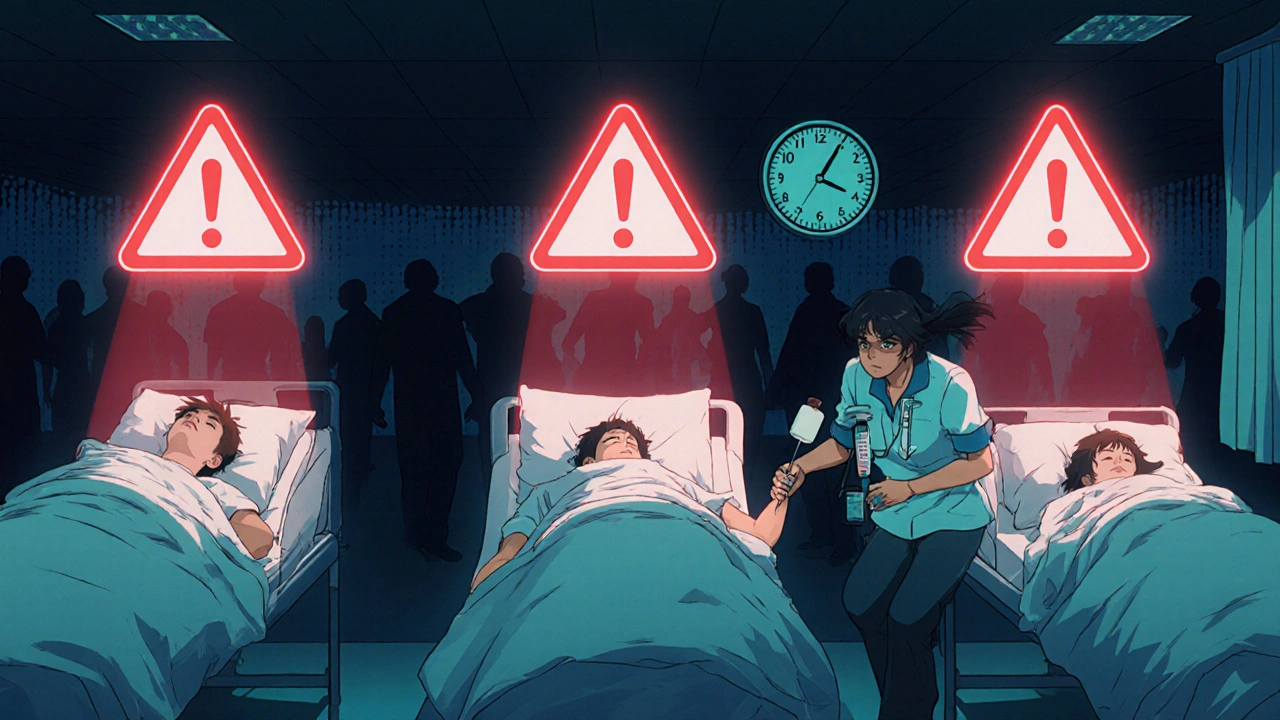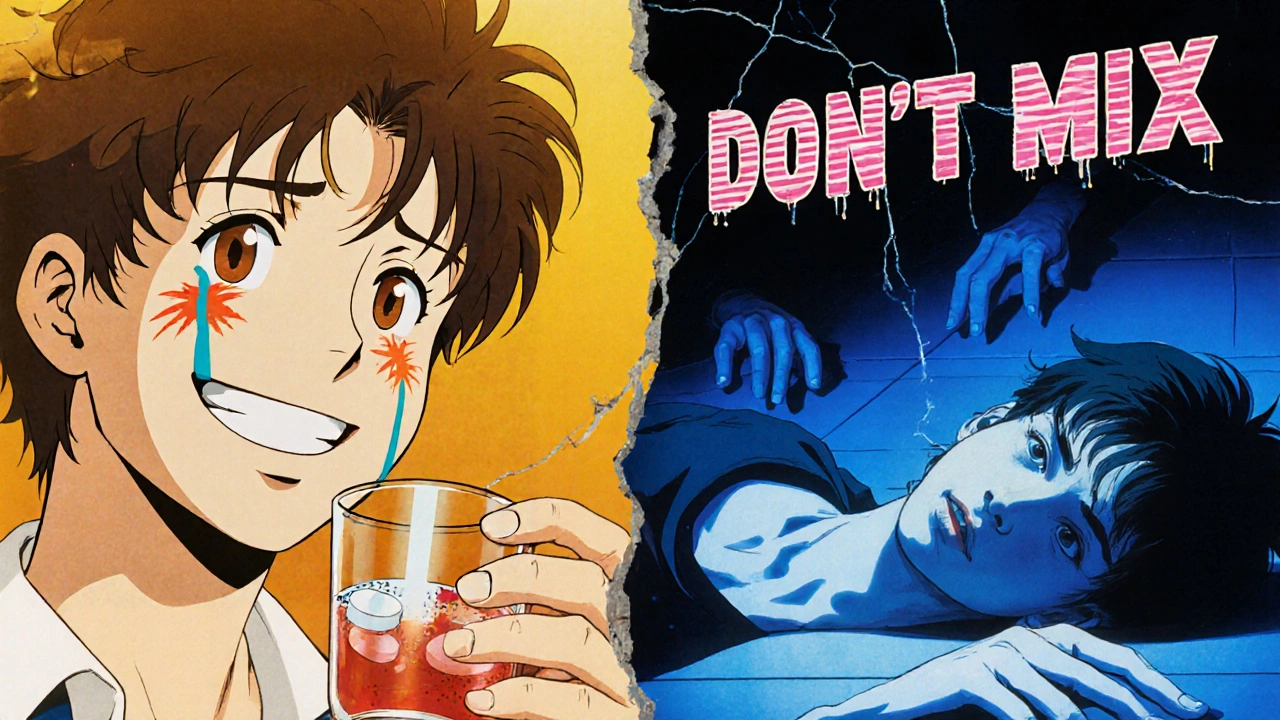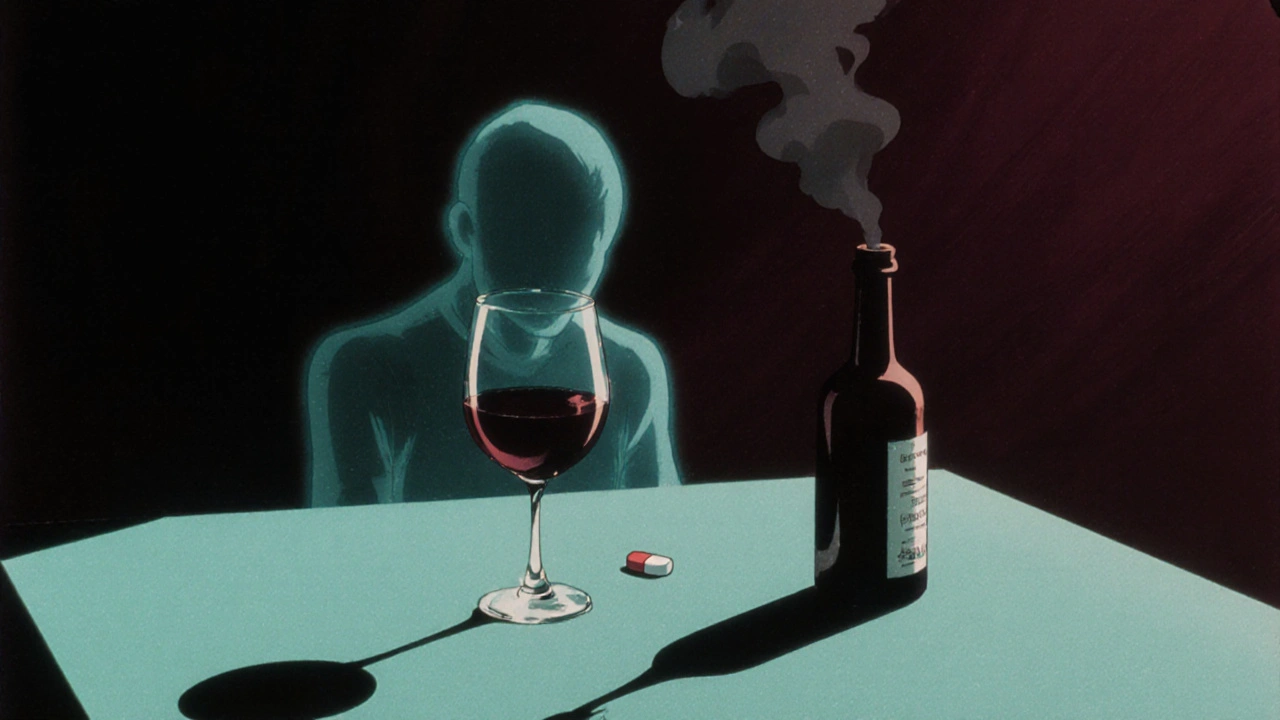Opioid-Alcohol Risk Calculator
Mixing alcohol and opioids can cause severe respiratory depression. There is no safe amount. This calculator estimates the breathing reduction risk based on dosage.
When you take opioids for pain, and you have a drink at dinner, you might think it’s harmless. After all, many people do it. But this combination isn’t just risky-it’s deadly. Mixing alcohol and opioids doesn’t just add danger; it multiplies it. And the result? A sharp, silent rise in overdose deaths that’s been growing for years.
Why This Combination Is So Dangerous
Both alcohol and opioids slow down your central nervous system. That’s why they make you feel relaxed, drowsy, or even euphoric. But when they’re together, they team up to shut down your breathing. It’s not a 1+1=2 situation. It’s more like 1+1=5. Your lungs don’t just slow-they stop. And when they stop, your brain doesn’t get oxygen. You pass out. You stop breathing. You die. The U.S. Food and Drug Administration (FDA) put a black-box warning on all prescription opioids in 2016 because the data was too clear to ignore. Alcohol was involved in nearly one in five opioid-related deaths. In 2022 alone, over 107,000 people in the U.S. died from drug overdoses. More than 80% of those involved more than one substance-and alcohol was often one of them.How Much Is Too Much?
There’s no safe amount. Even a single drink with a standard dose of oxycodone or hydrocodone can be enough. A 2017 study showed that just 20mg of oxycodone alone reduced breathing by 28%. Add alcohol to reach a blood alcohol level of 0.1%-the legal limit for driving in most U.S. states-and breathing dropped another 19%. Older adults were especially vulnerable. Their bodies process these substances slower, and their lungs are less able to recover. It doesn’t matter if you’re taking a prescription or buying pills off the street. Fentanyl, heroin, oxycodone, hydrocodone, methadone-they all react the same way with alcohol. In fact, synthetic opioids like fentanyl have seen the biggest jump in alcohol co-involvement. From 2010 to 2019, alcohol was found in 9% of fentanyl-related deaths. By 2019, that number was 17%.Who’s Most at Risk?
Men are more likely to die from this mix. In Texas, between 2010 and 2019, 77% of alcohol-opioid deaths were among men. But women aren’t safe either. Their bodies metabolize alcohol differently, which can make the effects more intense. People on methadone for opioid use disorder are at especially high risk. One study found they were 4.6 times more likely to die from an overdose if they drank alcohol. That’s not a small increase. It’s a red flag. And it’s not just recreational users. People prescribed opioids for chronic pain often drink to cope with stress, anxiety, or sleep problems. Doctors may not ask about alcohol use. Patients may not think to mention it. But the risk is real. The American Society of Addiction Medicine says patients with alcohol use disorder are 3.2 times more likely to overdose on opioids.
The Silent Killer: Respiratory Depression
The World Health Organization calls respiratory depression the main cause of opioid death. Alcohol makes it worse. It doesn’t just add to the effect-it lowers the threshold. That means someone might survive a certain dose of opioids alone, but with even a small amount of alcohol, that same dose becomes fatal. Post-mortem studies show alcohol is often found in the blood of people who died from buprenorphine overdoses. In one study, 30% of those deaths included alcohol. That’s not coincidence. It’s chemistry. And it’s not just opioids and alcohol. When benzodiazepines like Xanax or Valium are added to the mix, the risk spikes even higher. In 2021, nearly 14% of opioid deaths also involved benzodiazepines. Add alcohol to that, and you’ve got a triple threat.What’s Being Done?
The FDA now requires all opioid manufacturers to include clear warnings about alcohol in patient education materials. Starting in 2023, these warnings must be included in every prescription package. The Substance Abuse and Mental Health Services Administration (SAMHSA) launched the “Don’t Mix” campaign in early 2023 with $15 million to raise awareness. Harm reduction efforts are expanding. Naloxone, the drug that can reverse an opioid overdose, is now being distributed to people who use alcohol and opioids together. In Massachusetts, nearly a quarter of all naloxone reversals in 2022 involved alcohol. Some doctors are starting to screen for alcohol use before prescribing opioids. The American Society of Addiction Medicine recommends it. But too many still don’t. And many patients don’t know to tell them.
What You Can Do
If you’re taking opioids for any reason-whether it’s after surgery, for chronic pain, or for addiction treatment-alcohol is not an option. Not one drink. Not one beer. Not one glass of wine. Talk to your doctor. Be honest. If you’re drinking, say so. If you’re unsure whether your medication is safe with alcohol, ask. Don’t assume it’s okay because “everyone does it.” If you or someone you know uses opioids and alcohol, carry naloxone. Know how to use it. Keep it in your bag, your car, your pocket. It’s not a guarantee, but it’s your best chance. If you’re trying to cut back on alcohol or opioids, reach out. Support is out there. You don’t have to do it alone. Treatment works. Recovery is possible.It’s Not Just a Warning-It’s a Lifesaver
This isn’t about fear-mongering. It’s about facts. The science is clear. The deaths are real. And they’re preventable. You don’t need to be an addict to die from this mix. You just need to think it’s safe. That’s the trap. That’s how it happens. One night. One drink. One pill. And then silence. Don’t gamble with your life. Or someone else’s.Can you die from mixing alcohol and opioids even if you take them as prescribed?
Yes. Even when taken exactly as prescribed, combining alcohol with opioids can cause fatal respiratory depression. The FDA requires black-box warnings on all prescription opioids because this interaction is dangerous at any dose. A single drink with a standard opioid dose has been shown to reduce breathing by nearly 50% in some cases, especially in older adults or those with underlying health conditions.
Does the type of opioid matter when mixing with alcohol?
All opioids carry risk, but synthetic opioids like fentanyl and carfentanil are especially dangerous when mixed with alcohol. From 2010 to 2019, alcohol involvement in fentanyl-related deaths rose from 9% to 17%. Prescription opioids like oxycodone and hydrocodone also pose high risk, with alcohol found in up to 15% of related deaths. Heroin and methadone show similar patterns. No opioid is safe with alcohol.
How long should I wait after taking opioids before drinking alcohol?
There is no safe waiting period. Opioids can stay in your system for hours or even days, depending on the type. Extended-release forms like OxyContin or methadone linger much longer. Alcohol affects your body within minutes. The interaction happens regardless of timing. The only safe choice is to avoid alcohol completely while taking any opioid medication.
Can naloxone reverse an overdose caused by alcohol and opioids together?
Yes, naloxone can reverse the opioid component of the overdose, which restores breathing. But it does nothing to reverse alcohol’s effects. The person may still be at risk from alcohol poisoning or continued respiratory depression. Immediate medical help is still required after naloxone is given. Naloxone is a lifesaving tool, but not a complete solution.
Are there warning signs someone is overdosing from mixing alcohol and opioids?
Yes. Signs include slow or irregular breathing (less than 8 breaths per minute), blue or gray lips and fingertips, unresponsiveness, extreme drowsiness, gurgling sounds (like choking), and inability to wake up. These symptoms can appear quickly-even within minutes of mixing the substances. If you see them, call emergency services immediately and give naloxone if available.
Is it safe to drink alcohol while on buprenorphine or methadone for addiction treatment?
No. People on methadone or buprenorphine are at higher risk of overdose when drinking alcohol. Research shows methadone users who drink are 4.6 times more likely to die from an overdose. Buprenorphine-related deaths often include alcohol in toxicology reports. These medications help recovery, but alcohol undermines their safety. Abstaining from alcohol is strongly recommended during treatment.
What should I do if I accidentally mixed alcohol and opioids?
If you’ve mixed them and feel unusually drowsy, dizzy, confused, or have trouble breathing, seek emergency help immediately. Do not wait. Do not try to sleep it off. Call 999 or your local emergency number. If you have naloxone, use it. Even if you feel okay, monitor yourself closely for the next few hours. Symptoms can worsen slowly. When in doubt, get checked out.
If you’re struggling with opioid use or alcohol use, help is available. You’re not alone. Recovery isn’t about perfection-it’s about progress. Reach out to a healthcare provider, a support group, or a helpline today. Your life matters.


Jim Allen
October 31, 2025 AT 12:14krishna raut
November 2, 2025 AT 04:08Aditya Singh
November 3, 2025 AT 16:21caiden gilbert
November 4, 2025 AT 23:23Katherine Reinarz
November 5, 2025 AT 20:52Prakash pawar
November 5, 2025 AT 20:57Nate Girard
November 6, 2025 AT 20:59Erin Corcoran
November 8, 2025 AT 01:38Callum Breden
November 9, 2025 AT 16:55phenter mine
November 10, 2025 AT 00:27John Kane
November 10, 2025 AT 04:42Mansi Gupta
November 11, 2025 AT 11:57Carolyn Kiger
November 13, 2025 AT 05:53